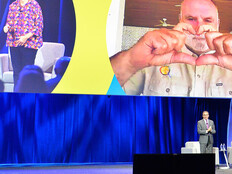LeadingAge 2019: Telehealth’s Growing Role in Senior Care
With older adults set to outnumber children by 2034, a greying U.S. population is highlighting a dual concern in senior care: a shortage of medical providers and high turnover among staff in acute care centers and skilled nursing facilities.
Telehealth tools that simplify nursing workflows and connect patients with doctors in a timely manner have big benefits for everyone involved, a panel of experts said on Sunday at the LeadingAge 2019 conference in San Diego.
The global telehealth market is valued at $49.8 billion and is poised to reach $266.8 billion by 2026. And as new federal rules allow Medicare Advantage plans to offer additional telehealth benefits next year, the potential for broader access to telehealth for seniors is becoming a reality.
But implementing telehealth in senior care requires strategic planning, a detailed review of IT infrastructure and open dialogue among leadership and employees, said Christopher Walker, vice president of clinical services at Sharp Memorial Hospital in Coronado, Calif.
“Ultimately, it’s going to be every team member’s commitment and engagement that makes an effort successful,” said Walker, who has overseen telehealth rollouts in several Sharp settings and at previous jobs in the skilled nursing care space.
When properly employed, the technology can be a morale booster for thinly stretched staff, a marketing tool to attract new clientele with the promise of on-demand expertise, and a comfort to loved ones if a physically taxing hospital transfer can be avoided.
All of these improvements, panelists noted, can benefit an organization’s bottom line.
Telehealth in Senior Care: How to Get Started
There isn’t a one-size-fits-all model for telehealth. That’s why senior care centers, like any providers seeking to adopt the technology, must first conduct a robust needs assessment to identify top areas of concern and involve all stakeholders in the discussion.
“It’s key to make sure your administrators, directors and nursing leaders are on board; they can help champion [a telehealth effort] to the rest of the staff,” said Josh Hofmeyer, senior care officer at Avera eCare, whose centralized virtual hospital hub in South Dakota provides telehealth services to more than 300 locations in eight states.
Panelists agreed that such communication, coupled with ongoing training, is crucial to inspire employees to adopt telehealth in facilitating care. It is also important for leaders of these conversations to identify the misconceptions and changing landscape — knowing about legal and regulatory issues, reimbursement and informed consent, among other points.
Each organization will have its own challenges, said Michael Kurliand, telehealth director at West Health in La Jolla, Calif. The group of nonprofit and nonpartisan organizations is dedicated to lowering healthcare costs for seniors to successfully age in place. Concerns may include delayed or lack of access to providers, care coordination and avoidable hospitalizations.
Adopters will also need to identify suitable payment models for vendor services, which can range from pay-per-use to unlimited access — and there’s often room to negotiate. “You can get creative,” said Kurliand, who advised organizations to consult their own legal team. “This is a whole new world.”
READ MORE: Discover five ways telehealth is taking modern healthcare to the next level.
Assessing IT Needs for Telehealth Programs
It takes about four to five months to launch a telehealth program in the senior care space, Hofmeyer said, and finding a suitable provider is just the start. Involving IT staff throughout is critical to ensure that a building's infrastructure is ready to handle bandwidth needs — and to keep tabs on usability and security needs, not only for the present but also the future.
“Just like any other type of technology, you’re going to want to constantly be on the alert for updates and changes,” said Hofmeyer, who compared telehealth evolution to that of laptops and smartphones. “As soon as you get it, there’s something newer or better.”
Still, adopters must look to scalable telehealth models to maximize ROI and expand their programs only as need and success dictate. “So many organizations spend $50,000 on a robot, and all they really needed was a $7 license per user for text and video that is HIPAA compliant,” Kurliand said.
This is why data collection during all stages of a telehealth program can give organizations the insight they need to target and refine their efforts. These data points, Hofmeyer said, should include how frequently — and in what capacity — virtual care services are being used; the resulting transfer outcomes; and patient satisfaction.
“The end goal is to have access to the right type of care needed to keep them out of the hospital,” Hofmeyer said.
Follow us on Twitter @HealthTechMag, or the official LeadingAge Twitter account, @LeadingAge, and join the conversation using the hashtag #LeadingAge19.









